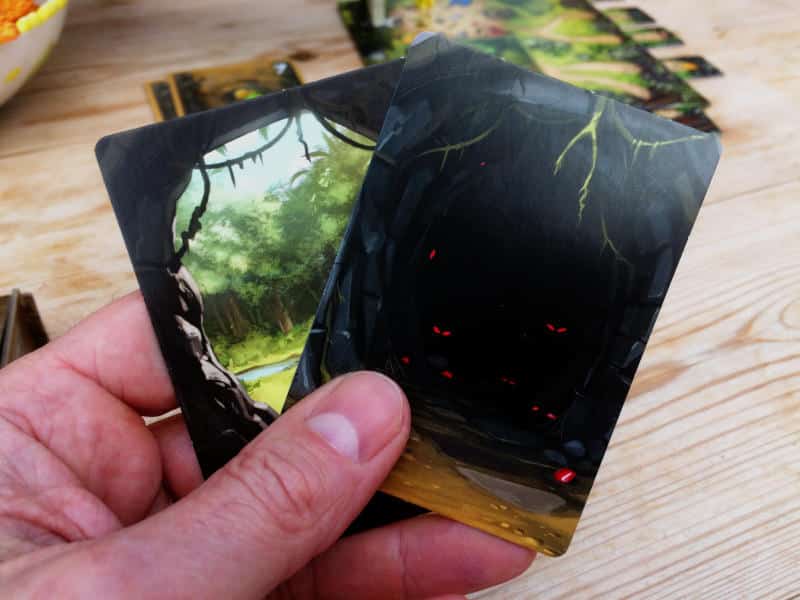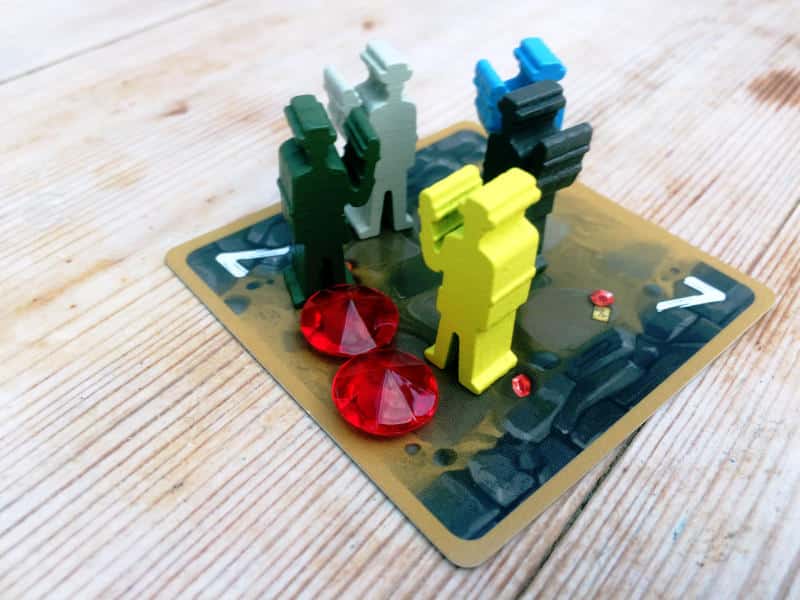| Release Date: 2016 | Players: 3-8 |
| Designer: Alan R. Moon, Bruno Faidutti | Length: 15-30 minutes |
| Artist: Christof Tisch, Claus Stephan, Jörg Asselborn, Matthias Catrein, Paul Mafayon, Prapach Lapamnuaysap, Robert Islas | Age: 6+ |
| Publisher: Iello | Complexity: 1.0 / 5 |
| Plastic (by weight): unknown | Air (by volume): unknown |
It was dark and damp. Of course, that was not unusual for the Tacora Cave, a giant underground system which was strewn with precious jewels and priceless artefacts. Those were the reason why we were here in the first place. Armed with our torches, we explored one tunnel after another, always mindful of traps. Sooner or later, one of us would get scared and make their way back to the entrance with their share of the treasures we had found so far. The rest of us continued, praying we would not fall foul of another trap and lose everything. After all, we wanted to get rich and find the most Diamant by Bruno Faidutti and Alan R. Moon from Iello.
No, the Tacora Cave doesn’t exist. It’s just a great name for a set of tunnels with endless caverns and plentiful traps that would make even intrepid fictional explorers such as Indiana Jones break out in a cold sweat and weigh up their chances of getting out with their treasure intact, before pushing on and on into the darkness until terrible spiders, a giant round boulder or some other lethal contraption would put an end to their exploration and lose them all the valuables they have collected underground. In fact, the name Tacora Cave is so cleverly chosen that when you search the internet for it, you will only find pages or videos about this wonderfully family-friendly push-your-luck game.
Diamanten
I assume the name Diamant is based on the German word for diamond. It’s these precious little jewels that you want to collect to win. Mind you, in the game, there are two types of plastic gem tokens: red and clear. The red rubies are worth one point each, while the clear diamonds are worth five. As you explore each tunnel system, you put out rubies that players can collect. At any time, you can exchange five rubies for one diamond. That’s all pretty straightforward.
The plastic gems are gorgeous. As I have mentioned before, in my review of Karuba for example, it’s one of the few occasions where I think plastic is the right choice. Seeing the jewels glint on the table is so atmospheric and exciting.
Anyway, I digress.
Diamant is a competitive game where you push your luck. As a group, you enter the first of five tunnels. Each tunnel consists of tiles drawn from a shuffled deck. Most tiles offer up a certain number of jewels, each worth one point. Others have artefacts on them, which represent larger chunks of points. Unfortunately, there are also five different types of traps. Draw the second tile of the same trap type and the journey is over. All treasure is lost and you go back to camp.
Luckily, before you proceed to the next tile, everyone votes if they want to continue or go back to camp. Everyone secretly chooses one of two cards to lock in their decision. Once everyone has picked their cards, they are all revealed. Players who decided to return to the entrance take their collected treasures with them, while the rest waits anxiously for what the next tile has in store for them.

Split the Treasure
Treasure is always split evenly. As the group enters a cave with jewels in it, everyone gets the same amount, with any remainder placed onto the cave tile itself. So in a five-player game, in a cave with 13 rubies in it, everyone gets 2 and the remaining 3 are left in the tunnel. It’s this division of loot that can sometimes slow down the game a little, unless you’re good with numbers. Mind you, it doesn’t take too long to pick up 13 rubies and go around the group and give everyone one of the gems until there aren’t enough left. If in doubt, you can always use the calculator on your phone, of course.
The good thing for those who return to camp is that they don’t just keep the rubies they have collected on the journey so far, but also evenly divvy up those gems that were left on the tiles. So those 3 jewels from my example above can look very tasty if you’re the only one who decides not to continue. That is, until the next tile has an even bigger amount of rubies on it, of course.
Also, as more and more players leave the group to go back to their tents and stash their treasure, the remaining group gets smaller, meaning that everyone ends up with a bigger share. It’s this clever little mechanism, which really is just very simple arithmetic and nothing particularly magical or special, that makes Diamant so great. When there are only two of you left and the next cavern tile has an amazing 10 jewels on it, each of you gets a deliciously huge heap of five gems.
It’s a Trap!
Of course, carrying treasure through an underground tunnel system is fraught with risks. As mentioned, if your group reveals a second trap of the same type, it’s all over. Everyone who hasn’t yet gone back to their tent has to return everything they gathered on this journey to the depths of the caves. Only the treasure that was brought back to the camp is safe.
So it’s all for the taking when you all embark on your very first adventure. Nobody has yet collected any jewels or artefacts. Your pockets are empty and your spirits are high. Once the first player rushes back to the cave entrance with a large handful of jewels, the pressure starts to increase. When you finally enter the third or fourth tunnel, some of you know that it’s now all or nothing. Other explorers will have already banked a good 10 to 20 gem points, while you’re still on a miserly four or five. It’s clear that you just have to keep pushing forward into the darkest and probably dampest depths of the cave system, traps or no traps.
If you can manage to find a precious artefact, ideally as the only one left underground and still make it out alive, you can turn a loss into a last-minute victory. Of course, the more you pray that the next tile presents you with the riches you need, the more likely it is to be a trap that drags you to your doom.

Delicious Diamant
I think Diamant is deliciously devious. It all starts light and fluffy, but soon becomes tense and full of anguish. Table talk will be likely, as players try to psych each other out, hoping their nerves will get the better of them. At the same time though, it is a really wonderful family game. It’s very quick to explain and pretty quick to play at the same time. I don’t think I have played a single game that took longer than 20 minutes.
Of course, you can draw it out and raise the suspense by allowing players to try and negotiate what they might or might not do, especially if you don’t play with younger kids. At the same time, even young kids will understand what they need to do. It’s also a great way of practising some basic arithmetic with them. So, Diamant definitely appeals to a wide range of player ages.
It’s also great for people who like games to tell a story. The Indiana Jones vibes are clear, not only because of the boulder trap. You’re in a jungle, everyone has pitched their tent and you’re about to head underground into an unknown cave system. Your imagination is bound to have a field day if you let it. Alternatively, you can play it more like a poker game and keep it more serious. It’s really up to you and the people you play with. Diamant will most definitely appeal to lots of different people.
Either way, if you get a chance, then I strongly recommend you give the game a try. I doubt that you will be disappointed.
Useful Links
- Diamant: https://iello.
fr/ jeux/ diamant/ - Rulebook: https://boardgamegeek.
com/ filepage/ 136662/ english-rules-2016-iello-version - Iello: https://iello.
fr/ - BGG listing: https://boardgamegeek.
com/ boardgame/ 15512/ incan-gold - Karuba review: https://tabletopgamesblog.
com/ 2023/ 04/ 08/ karuba-saturday-review/
Transparency Facts
I feel that this review reflects my own, independent and honest opinion, but the facts below allow you to decide whether you think that I was influenced in any way.- I played a friend's copy of the game.
- At the time of writing, neither the designers, nor the publisher, nor anyone linked to the game supported me financially or by payment in kind.
Audio Version
Intro Music: Bomber (Sting) by Riot (https://www.
Sound Effects: bbc.co.uk – © copyright 2023 BBC
The following music was used for this media project:
Music: The Big Adventure by Sascha Ende
Free download: https://filmmusic.io/song/431-the-big-adventure
License (CC BY 4.0): https://filmmusic.io/standard-license

